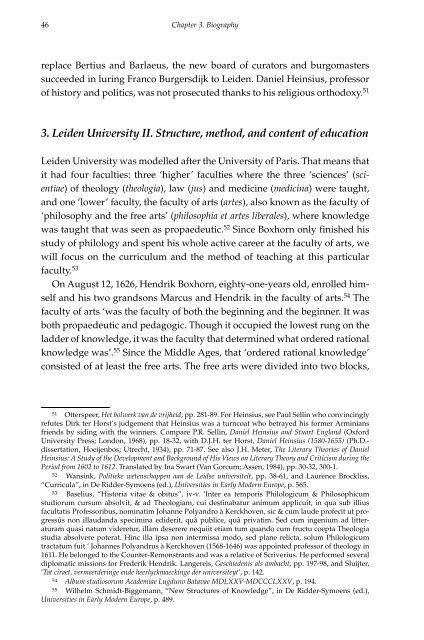historical and political thought in the seventeenth - RePub - Erasmus ...
historical and political thought in the seventeenth - RePub - Erasmus ...
historical and political thought in the seventeenth - RePub - Erasmus ...
Create successful ePaper yourself
Turn your PDF publications into a flip-book with our unique Google optimized e-Paper software.
46<br />
Chapter 3. Biography<br />
replace Bertius <strong>and</strong> Barlaeus, <strong>the</strong> new board of curators <strong>and</strong> burgomasters<br />
succeeded <strong>in</strong> lur<strong>in</strong>g Franco Burgersdijk to Leiden. Daniel He<strong>in</strong>sius, professor<br />
of history <strong>and</strong> politics, was not prosecuted thanks to his religious orthodoxy. 51<br />
3. Leiden University II. Structure, method, <strong>and</strong> content of education<br />
Leiden University was modelled after <strong>the</strong> University of Paris. That means that<br />
it had four faculties: three ‘higher’ faculties where <strong>the</strong> three ‘sciences’ (scientiae)<br />
of <strong>the</strong>ology (<strong>the</strong>ologia), ), law (jus ( ) <strong>and</strong> medic<strong>in</strong>e (medic<strong>in</strong>a) were taught,<br />
<strong>and</strong> one ‘lower’ faculty, <strong>the</strong> faculty of arts (artes), also known as <strong>the</strong> faculty of<br />
‘philosophy <strong>and</strong> <strong>the</strong> free arts’ (philosophia et artes liberales), where knowledge<br />
was taught that was seen as propaedeutic. 52 S<strong>in</strong>ce Boxhorn only f<strong>in</strong>ished his<br />
study of philology <strong>and</strong> spent his whole active career at <strong>the</strong> faculty of arts, we<br />
will focus on <strong>the</strong> curriculum <strong>and</strong> <strong>the</strong> method of teach<strong>in</strong>g at this particular<br />
faculty. 53<br />
On August 12, 1626, Hendrik Boxhorn, eighty-one-years old, enrolled himself<br />
<strong>and</strong> his two gr<strong>and</strong>sons Marcus <strong>and</strong> Hendrik <strong>in</strong> <strong>the</strong> faculty of arts. 54 The<br />
faculty of arts ‘was <strong>the</strong> faculty of both <strong>the</strong> beg<strong>in</strong>n<strong>in</strong>g <strong>and</strong> <strong>the</strong> beg<strong>in</strong>ner. It was<br />
both propaedeutic <strong>and</strong> pedagogic. Though it occupied <strong>the</strong> lowest rung on <strong>the</strong><br />
ladder of knowledge, it was <strong>the</strong> faculty that determ<strong>in</strong>ed what ordered rational<br />
knowledge was’. 55 S<strong>in</strong>ce <strong>the</strong> Middle Ages, that ‘ordered rational knowledge’<br />
consisted of at least <strong>the</strong> free arts. The free arts were divided <strong>in</strong>to two blocks,<br />
51 Otterspeer, Het bolwerk van de vrijheid, pp. 281-89. For He<strong>in</strong>sius, see Paul Sell<strong>in</strong> who conv<strong>in</strong>c<strong>in</strong>gly<br />
refutes Dirk ter Horst’s judgement that He<strong>in</strong>sius was a turncoat who betrayed his former Arm<strong>in</strong>ians<br />
friends by sid<strong>in</strong>g with <strong>the</strong> w<strong>in</strong>ners. Compare P.R. Sell<strong>in</strong>, Daniel He<strong>in</strong>sius <strong>and</strong> Stuart Engl<strong>and</strong> (Oxford<br />
University Press; London, 1968), pp. 18-32, with D.J.H. ter Horst, Daniel He<strong>in</strong>sius (1580-1655) (Ph.D.dissertation,<br />
Hoeijenbos; Utrecht, 1934), pp. 71-87. See also J.H. Meter, The Literary Theories of Daniel<br />
He<strong>in</strong>sius: A Study of <strong>the</strong> Development <strong>and</strong> Background of His Views on Literary Theory <strong>and</strong> Criticism dur<strong>in</strong>g <strong>the</strong><br />
Period from 1602 to 1612. Translated by Ina Swart (Van Gorcum; Assen, 1984), pp. 30-32, 300-1.<br />
52 Wans<strong>in</strong>k, Politieke wetenschappen aan de Leidse universiteit, pp. 38-61, <strong>and</strong> Laurence Brockliss,<br />
“Curricula”, <strong>in</strong> De Ridder-Symoens (ed.), Universities <strong>in</strong> Early Modern Europe, p. 565.<br />
53 Baselius, “Historia vitae & obitus”, iv-v. ‘Inter ea temporis Philologicum & Philosophicum<br />
studiorum cursum absolvit, & ad Theologiam, cui dest<strong>in</strong>abatur animum applicuit, <strong>in</strong> qua sub illius<br />
facultatis Professoribus, nom<strong>in</strong>atim Johanne Poly<strong>and</strong>ro à Kerckhoven, sic & cum laude profecit ut progressûs<br />
non illaud<strong>and</strong>a specim<strong>in</strong>a ediderit, quâ publice, quâ privatim. Sed cum <strong>in</strong>genium ad litteraturam<br />
quasi natum videretur, illam deserere nequiit etiam tum qu<strong>and</strong>o cum fructu coepta Theologia<br />
studia absolvere poterat. H<strong>in</strong>c illa ipsa non <strong>in</strong>termissa modo, sed plane relicta, solum Philologicum<br />
tractatum fuit.’ Johannes Poly<strong>and</strong>rus à Kerckhoven (1568-1646) was appo<strong>in</strong>ted professor of <strong>the</strong>ology <strong>in</strong><br />
1611. He belonged to <strong>the</strong> Counter-Remonstrants <strong>and</strong> was a relative of Scriverius. He performed several<br />
diplomatic missions for Frederik Hendrik. Langereis, Geschiedenis als ambacht, pp. 197-98, <strong>and</strong> Sluijter,<br />
‘Tot ciraet, vermeerder<strong>in</strong>ge ende heerlyckmaeck<strong>in</strong>ge der universiteyt’, p. 142.<br />
54 Album studiosorum Academiae Lugduno Batavae MDLXXV-MDCCCLXXV, MDLXXV-MDCCCLXXV p. 194.<br />
55 Wilhelm Schmidt-Biggemann, “New Structures of Knowledge”, <strong>in</strong> De Ridder-Symoens (ed.),<br />
Universities <strong>in</strong> Early Modern Europe, p. 489.

















